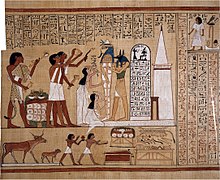Iunmutef
| Iunmutef in hieroglyphics | |||||||
|---|---|---|---|---|---|---|---|
| Old empire |
|
||||||
| Middle realm |
|
||||||
| New kingdom |
Iunmutef (Iun mutef) Jwn mw.t = f pillar of his mother |
||||||
Iunmutef (also Iun-mutef or Inmutef ) is a god of the dead in ancient Egyptian mythology. In the older literature connections to Kamutef and Wadjmutef are assumed. However, recent research has limited the similarity to name formation only.
background
Role assignment of the Iunmutef
Iunmutef symbolizes the caring son of Osiris in the context of Horus , who results from the cult of the dead. Thus Iunmutef has the character of a son who cares for his dead father. The name component Iun as a pillar shows the mythical interpretation as a social family principle, which Iunmutef identifies with the assignment of sonship and his responsibility in the family group. As a son, Junmutef can animate and regenerate the father and open his way to eternal rule.
In the reign of Thutmose III. the name of Iunmutef is written in Karnak with the divine determinative in connection with a panther skin . This writing symbolizes the aspects of a sonship and the associated priesthood with regard to the young Thutmose III. in his temple work and his divine father Amun-Re . The panther skin is closely related to Iunmutef's priesthood, as whose image the young Thutmose III. understanding.
Iunmutef and the mouth opening ritual
In the opening of the mouth ceremony Iunmutef in occurs appearance on the divine son Horus, and thus represents the mythological divine ritual level . The separation of the worldly plane, which the Sem priest symbolized, can be seen in every detail in the depictions of the tomb of Seti .
In the area of the mortuary temple and burial rites, Iunmutef is the practitioner of certain elements of the mouth opening ritual, for example cleansing of the deceased. In the grave, the mouth opening rites performed by Iunmutef focus on resuscitation and body preparation as well as on the introduction of the deceased into the duat . In the temple itself the purifications have the purpose of reviving the king in the sacrificial ritual and characterize this process as a cult of the renewal process.
See also
literature
- Hans Bonnet : Lexicon of the Egyptian religious history. Hamburg 2000, Nikol Verlag, pp. 324-325, ISBN 3-937872-08-6 .
- Helen Jacquet-Gordon: Les noms des domaines funéraires sous l'ancien empire égyptien. Institut Français d'Archéologie Orientale, Cairo 1962, p. 355.
Individual evidence
- ↑ James-Henry Breasted : A new chapter in the life of Thutmose III . Hinrichs, Leipzig 1900, p. 31.
